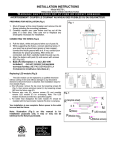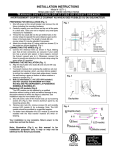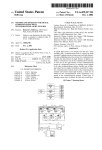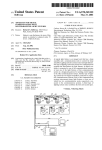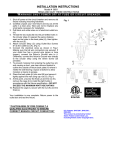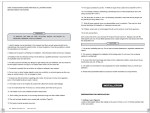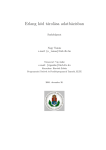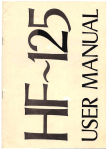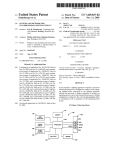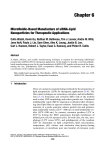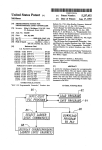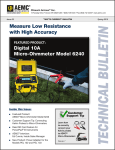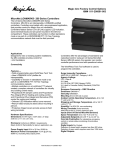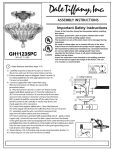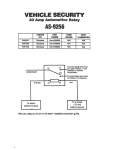Download Apparatus for digital communications with multiparameter light fixtures
Transcript
US006664745B2 (12) United States Patent (10) Patent N0.: Belliveau (45) Date of Patent: (54) APPARATUS FOR DIGITAL COMMUNICATIONS WITH MULTIPARAMETER LIGHT FIXTURES (76) 6,459,217 B1 10/2002 Belliveau 2003/0001523 A1 1/2003 Richard S. Belliveau, 10643 Floral Park, Austin, TX (US) 78759 Notice: Dec. 16, 2003 FOREIGN PATENT DOCUMENTS US Inventor: US 6,664,745 B2 OTHER PUBLICATIONS Subject to any disclaimer, the term of this patent is extended or adjusted under 35 Carlson, Steven B., A Guided Tour of DMX512, ROXCO/ Entertainment Technology, Mar. 25, 1996. U.S.C. 154(b) by 0 days. High End Systems, Inc., High End Systems Product Line, 1996. Clay Paky Light Dimension, Golden Scan: The absolute winner, in Light Dimensions, Dec. 1988. Electronic Theatre Controls, Inc., Sensor CEM Dimming System User Manual, Version 2.14, 1996. Electronic Theatre Controls, Inc., Sensor CEM Dimming System User Manual, Version 3.0, 1998. (21) Appl. No.: 10/444,854 May 22, 2003 (22) Filed: Prior Publication Data (65) US 2003/0208291 A1 Nov. 6, 2003 Related US. Application Data (60) (51) (52) (58) Continuation of application No. 10/231,823, ?led on Aug. 29, 2002, now Pat. No. 6,570,348, which is a continuation of application No. 10/002,708, ?led on Nov. 1, 2001, now Pat. No. 6,459,217, which is a division of application No. Primary Examiner—David Hung Vu (74) Attorney, Agent, or Firm—Altera Law Group, LLC (57) ABSTRACT 09/394,300, ?led on Sep. 10, 1999, now Pat. No. 6,331,756. A typical light ?xture is an integral unit that has a lamp assembly and a communications node to control the lamp Int. Cl.7 .............................................. .. H05B 37/00 assembly. Lighting systems contain many such light ?xtures. US. Cl. ...................... .. 315/315; 315/316; 315/317 Field of Search ............................... .. 315/315, 316, One type of lighting system has at least two communications systems that interconnect the light ?xtures. A digital con 315/317, 312 troller is connected to one of the communications systems, at least one of the light ?xtures of that communications References Cited (56) U.S. PATENT DOCUMENTS 3,706,914 3,898,643 4,095,139 4,697,227 4,980,806 5,828,485 6,331,756 6,388,399 A A A A A A B1 B1 12/1972 8/1975 6/1978 9/1987 12/1990 10/1998 12/2001 5/2002 Van Buren Ettlinger Symonds et al. Callahan Taylor et al. Hewlett Belliveau Eckel et al. system is a designated gateway for sending control signals to the other communications system. Another type of light ing system has two digital controllers connected to respec tive communications systems. Each of the communications systems interconnects many light ?xtures, at least one of which has two communications nodes respectively con nected to the communications systems. A third type of lighting system mixes combines the ?rst and second types. 25 Claims, 7 Drawing Sheets m .15. N 640 U U.S. Patent Dec. 16, 2003 Sheet 1 6f 7 @6969 “H’Q FIG. 1 (PRIOR ART) US 6,664,745 B2 U.S. Patent Dec. 16, 2003 Sheet 2 6f 7 US 6,664,745 B2 100 112 104* @ °<___//1o6 A . O . 1 l 104 \0 / D 114/ 1 1 108 ,_-/ 108 /110 110 FIG.2 FIG.3 (PRIOR ART) (PRIOR ART) U.S. Patent Dec. 16, 2003 Sheet 3 0f 7 US 6,664,745 B2 LIGHTING COMMUNICATIONS SYSTEM FlklrcigES m 3.22 LIGHT FIXTURE UGHTING m OIGrrAL CONTROLLER COMMUN‘CAT'ONS LIGHT FIXTURES w SYSTEM m m uGHT FIXTURE m LIGHTING COMMUNICATIONS SYSTEM L'GHT FIXTURES a 3.39. LIGHTING COMMUNICATIONS 0'6"”CONTROLLER SYSTEM 592 m | LIGHT FIXTURES UGHT FIXTURES 5.1!! 512 J LIGHTING COMMUNICATIONS SYSTEM 0'6"”CONTROLLER 5% ] ' 5% FIG. 5 U.S. Patent Dec. 16, 2003 /514 Sheet 4 6f 7 4} US 6,664,745 B2 U.S. Patent Dec. 16, 2003 617 Sheet 5 6f 7 644 618 I US 6,664,745 B2 645 619 646 ,4’ 1' / $165, c: ‘LYN-:1: ' I 624 i I 6? i I I ? / Q I l I I I l I I I l. 647 II \:l 8 Q / 4 @II I __..__-________I L__________________<1=:z____-______ 640 616 / FIG. 7 U.S. Patent Dec. 16, 2003 Sheet 6 6f 7 US 6,664,745 B2 CABLE c INTERFACE - ZQg MICRO PROCESSOR SUBSYSTEM 112 CABLE c INTERFACE - 1% ~ POWER Va SUPPLY 712 FIG. 8 CABLE C INTERFACE — 19g MICRO PROCESSOR SUBSYSTEM POWER LINE INTERFACE m - 5.0.2 Tfl' l [ POWER SUPPLY 112 FIG. 9 U.S. Patent Q Dec. 16, 2003 Sheet 7 6f 7 ; CABLE j INTERFACE US 6,664,745 B2 -— m MICRO a PROCESSOR I} I l SUBSYSTEM I TRANSCEIVER RF TRA9NOS2CElVER__ — ‘NTERFACE m _ ? POWER VA I SUPPLY 5 11.2 COM IN I>_ OTHER INTERFACE CIRCUITS 1006 COM OUT <*— COM 'N’OUT ° 1202 1302 COM IN D_I§_ OTHER INTERFACE CIRCUITS COM OUT J OTHER INTERFACE CIRCuITs 1106 271 1204 FIG. 13 ?/ OTHER INTERFACE CIRCUITS COM 'N/OUT 1206 1306 1304 FIG. 14 US 6,664,745 B2 1 2 APPARATUS FOR DIGITAL COMMUNICATIONS WITH MULTIPARAMETER LIGHT FIXTURES typically multi-parameter lighting systems may have thirty or more such light ?xtures. Communication is in a single direction, as shoWn by arroWs adjacent the communications cable 16 and cable segments 21, 23, 25, 31, 33 and 35. From time to time, light ?xtures must be placed in locations Which CROSS-REFERENCE TO RELATED APPLICATION are hard to reach or otherWise present dif?culties during installation and cabling. A hard to reach or difficult area 30 The present application is a continuation of US. Ser. No. containing light ?xtures 32, 34 and 36 is included in FIG. 1. 10/231,823, ?led Aug. 29, 2002, now US. Pat. No. 6,570, 348, Which application is a continuation of US. application multi-parameter lighting system of FIG. 1 is shoWn in Ser. No. 10/002,708, ?led Nov. 1, 2001, now US. Pat. No. 6,459,217, Which is a division of US. application Ser. No. 09/394,300, ?led Sep. 10, 1999, now US. Pat. No. 6,331, 756, Which are incorporated herein by reference thereto in their entirety, as though fully set forth herein. An illustrative light ?xture 100 suitable for use in the 10 15 various buttons for manually setting the operating address of BACKGROUND OF THE INVENTION 1. Field of the Invention The present invention relates to digital control of lighting devices, and more particularly to digital control of large 20 lighting systems, including systems having multi-parameter 2. Description of Related Art signi?cant reductions in overall lighting system siZe and permit dynamic changes to the ?nal lighting effect. Appli the light ?xture 100. The side vieW of FIG. 3 shoWs that the electronics module 104 also includes a pair of digital com munications terminals, one of Which is a digital input terminal 112 designated DIGITAL LINE IN and the other of Which is a digital output terminal 114 designated DIGITAL LINE OUT. Internally, the input terminal 112 typically is looped through to the output terminal 114. Respective com light ?xtures, With multiple communications systems. Multi-parameter light ?xtures, Which include light ?x tures having individually remotely adjustable beam siZe, color, shape, angle, and other light characteristics, are Widely used in the lighting industry because they facilitate greater detail in FIGS. 2 and 3. The front vieW of FIG. 2 shoWs a light housing 110 Which is rotatably attached to a yoke 108. The yoke 108 is in turn rotatably attached to an electronics module 104, Which contains a poWer supply and communications and control electronic circuits. Apanel area 106 on the electronics module 104 contains a display and munications cables plug into the terminals 112 and 114. A 25 line cord 102 for connecting the multi-parameter light ?xture 100 to the poWer line extends from the electronics 30 cations and events in Which multi-parameter light ?xtures are used to great advantage include showrooms, television module 104. Illustrative multi-parameter light devices are described in the product brochure entitled The High End Systems Product Line 1996 and are available from High End Systems, Inc. of Austin, Tex. To maintain reliability throughout the multi-parameter lighting system, the communications cables typically are lighting, stage lighting, architectural lighting, live concerts, dedicated metallic or ?ber optic cables. One reason is the and theme parks. In practice, the multi-parameter light ?xtures of a system are typically controlled by a central controller. Prior to the central controller for the multi-parameter light ?xtures of a system may be a considerable distance from the light ?xtures. For example, central controllers may be located advent of relatively small commercial digital computers, over one hundred meters from the light ?xtures they control 35 remote control of light ?xtures from a central controller Was in such places as large arenas, theaters, and auditoriums. done With either a high voltage or loW voltage current; see, e.g., US. Pat. No. 3,706,914, issued Dec. 19, 1972 to Van Buren, and US. Pat. No. 3,898,643, issued Aug. 5, 1975 to Lengthy cable runs are also found in commercial buildings in Which light ?xtures are used for architectural lighting, since the communications cables must pass from ?oor to 40 Ettlinger. With the Widespread use of computers, digital ?oor or betWeen Widely separated rooms on the same ?oor. serial communications Was Widely adopted as a Way to Moreover, a typical large lighting system contains over thirty light ?xtures and a corresponding number of commu achieve remote control; see, e.g., US. Pat. No. 4,095,139, issued Jun. 13, 1978 to Symonds et al., and US. Pat. No. 45 4,697,227, issued Sep. 29, 1987 to Callahan. Digital communications betWeen the central controller and the central controller to the poWer mains and their respective communications cables. Installation of multi and the multi-parameter light ?xtures typically is by Wire. In 1986, the United States Institute of Theatre Technology (“USITT”) developed a digital communications system pro parameter lighting systems tend to be quite costly, taking 50 tocol for multi-parameter light ?xtures knoWn as DMX512. While the DMX512 protocol has been updated several times into consideration the individual costs of the cables, the associated connectors, and the labor involved in installing them. During the transition from analogue control to digital since its adoption, the basic communications protocol remains the same. Basically, the DMX512 protocol consists of a stream of data Which is communicated one-Way from 55 the control device to the light ?xture using an Electronics Industry Association (“EIA”) standard for multipoint com munications knoW as RS-485. FIG. 1 shoWs an illustrative system based on the USITT DMX512 protocol. PoWer mains 12 provide AC poWer to a central controller 10 and nications cables betWeen the light ?xtures, and requires signi?cant labor to connect securely each of the light ?xtures 60 control, some multi-parameter light ?xtures Were con structed With both a digital and an analog means of com munication. An example of such a device is the TrackSpot® automated luminaire, Which is described in the product brochure entitled The High End Systems Product Line 1996 and is available from High End Systems Inc. of Austin, Tex. The TrackSpot system has a Wide variety of control options, including digital and analog. The analog communication is light ?xtures 20, 22, 24, 26, 32, 34 and 36 over standard building electrical Wiring 14. A communications cable 16 is designed as an input, and the device is manually selectable run from the central controller 10 to the ?rst multi-parameter betWeen the digital and analog input schemes. The analog light ?xture 20, and additional communication cable seg ments 21, 23, 25, 31, 33 and 35 sequentially connect the light ?xtures 22, 24, 26, 32, 34 and 36. While only seven multi-parameter light ?xtures are shoWn in FIG. 1 for clarity, communication to the device controls the device that it is 65 connected to, Whereas the digital communications “loops through” from light to light With an addressable signal scheme for controlling multiple addressed light ?xtures. US 6,664,745 B2 4 3 The TrackSpot ?xture is physically switched on the FIG. 3 is a plan side vieW of the multi-parameter light ?xture to assume either a master or a slave position. With the ?xture of FIG. 2. FIG. 4 is a block schematic diagram of a lighting system ?xture set to the master position, an analog signal at the analog input to the ?xture causes the master to execute a particular one of numerous memory resident programs based on the analog value it receives. The master also sends a digital signal to the other ?xtures that are set up as “slaves” to cause them to act on their respective memory resident programs. having communications systems in accordance With the present invention. FIG. 5 is a block schematic diagram of another lighting system having communications systems in accordance With the present invention. FIG. 6 is a schematic diagram of lighting system having Despite advances in the control of large lighting systems, a cable communications system and a poWer line commu a need exists for improving the digital control of large systems that include multi-parameter light ?xtures. SUMMARY OF THE INVENTION Accordingly, an obj ect of the present invention as realiZed in particular embodiments is to reduce the cost of installing 15 and dismantling complex lighting systems generally, and multi-parameter lighting systems particularly. Another object of the present invention as realiZed in particular embodiments is to provided a multi-parameter light ?xture that supports multiple levels of communications shoWing various terminal arrangements. DETAILED DESCRIPTION OF THE PREFERRED EMBODIMENT for controlling complex lighting systems generally, and multi-parameter lighting systems particularly. Yet another object of the present invention as realiZed in particular embodiments is to extend the capabilities of 25 complex lighting systems generally, and multi-parameter lighting systems particularly, While maintaining essential core reliability. These and other objects are achieved in the various embodiments of the present invention. For example, one embodiment of the present invention is a multi-parameter Which communicated using any suitable protocol such as a one Way communications protocol, the DMX512 protocol for example, or a bi-directional communications protocol. A 35 ?rst digital communications node being addressable from and netWorkable in a ?rst external communications system and having a ?rst control output coupled to the lamp assembly for controlling at least one of the parameters; and the second digital communications node being addressable light ?xture reside in the ?xture and are part of it. A lamp assembly for a multi-parameter light ?xture includes a lamp, typically but not necessarily a high intensity lamp, and one from and netWorkable in a second external communications 45 tilt, iris, independent or interactive three color effects, and rotating and static gobo patterns. 55 Generally, a gateWay is any electronic circuit that permits signals to pass betWeen communications systems either unidirectionally or bi-directionally. GateWays may or may not perform protocol conversion, depending on Whether the communications systems operate on different communica tions protocols. Suitable gateWay circuits and protocol con verters are Well knoWn in the electronic circuit arts. The lighting system of FIG. 4 illustratively has three lighting communications systems 310, 320 and 330. A Which may be activated by a human-operated sWitch or in response to an activation command. BRIEF DESCRIPTION OF THE DRAWINGS FIG. 1 is a schematic diagram of a prior art lighting FIG. 2 is a plan front vieW of a multi-parameter light ?xture. folloWing: motors, ?lters, lenses, prisms, gobo Wheels, effects such as frost and diffusion, Zoom and focus, pan and output coupled to the lamp assembly for controlling at least system. or more other components such as, but is not limited to, the shutters, iris diaphragms, and circuits for achieving optical tions node. In a further embodiment of the foregoing, the electronics module further comprises a third digital communications node being addressable from and netWorkable in a third external communications system and having a third control one of the parameters; and the multi-parameter light ?xture further comprises a further gateWay circuit coupled betWeen the ?rst digital communications node and the third digital communications node. In further embodiments of the multi-parameter light ?xture, the gateWay circuit implements a gateWay function multi-parameter light ?xture is an integral unit that includes a lamp assembly and one communications node, or an integral unit that includes a lamp assembly and tWo or more communications nodes, or an integral unit that includes a lamp assembly, tWo or more communications nodes, and a gateWay circuit or circuits betWeen the communications nodes. The communications nodes of a multi-parameter tions node and a second digital communications node; the system and having a second control output coupled to the lamp assembly for controlling at least one of the parameters; and a gateWay circuit coupled betWeen the ?rst digital communications node and the second digital communica Lighting systems that include multi-parameter light ?x tures and multiple digital communications systems are gen erally characteriZed by FIG. 4, by FIG. 5, or by a combi nation of FIGS. 4 and 5. These systems include digital controllers (controller 302 in FIG. 4 and controllers 402 and 406 in FIG. 5) Which issue digital commands recogniZable by nodes in the system that control the light effects, and light ?xture comprising a lamp assembly comprising a plurality of components for implementing parameters; an electronics module comprising a ?rst digital communica nications system, in accordance With the present invention. FIG. 7 is a schematic diagram of lighting system having tWo communications systems With respective controllers, in accordance With the present invention. FIGS. 8, 9 and 10 are block schematic diagrams shoWing various arrangements of communications systems interfaces, in accordance With the present invention. FIGS. 11, 12, 13 and 14 are block schematic diagrams 65 digital controller 302 is connected to the communications system 310 and light ?xtures 312, 314 and 316 are inter connected by the communications systems 310 in any suit able Way. Light ?xtures 314 and 322 are interconnected by the communications systems 320 in any suitable Way. Light ?xtures 316 and 332 are interconnected by the communica tions systems 330 in any suitable Way. Some light ?xtures include gateWays betWeen tWo or more of the communica US 6,664,745 B2 5 6 tions systems, through Which at least some of the control signals from the communications system 310 are furnished to the communications systems 320 and 330. For example, tures communicating over a second lighting communica tions system. Although the second communications system may be of the same type as the ?rst, preferably the second communications system is of a different type. Where the ?rst communications system is a cable based system, for example, the second system may be a Wired or Wireless communications system and may have greater speed or another performance advantage or ease of installation or other capability that the ?rst system does not have. For example, a second communications system may conform to light ?xture 314 includes a gateWay circuit (not shoWn) betWeen the communications systems 310 and 320, and is controllable from the communications system 310. Similarly, light ?xture 316 includes a gateWay circuit (not shoWn) betWeen the communications systems 310 and 330, and is controllable from the communications system 310. While FIG. 4 shoWs only one gateWay installed betWeen the ANSI/EIA-600 protocol used for the CEBus. Light ?xtures conforming to this protocol Would be compatible With and could be controlled from other devices conforming to the ANSI/EIA-600 protocol if desired. different communications systems, more than one gateWay may be installed betWeen different communications systems if desired. While FIG. 4 shoWs three lighting communica tions systems 310, 320 and 330, the use of only tWo or three or more communications systems is contemplated. 15 In the lighting system of FIG. 5, the digital controller 402 is connected to lighting communications system 404 and light ?xtures 410 are interconnected by the communications systems 404 in any suitable Way. The digital controller 406 is connected to lighting communications system 408 and The use of a multi-parameter light ?xture acting as a gateWay from one communications system to another dif ferent communications system may be better understood from the folloWing example. Amulti-parameter light ?xture resident on a ?rst communications system receives and preferably performs an operation in accordance With com mands from a particular command set. If the multi parameter light ?xture is also a gateWay, it retransmits those light ?xtures 410 and 412 are interconnected by the com munications systems 408 in any suitable Way. Some light ?xtures such as light ?xtures 410 are controllable from both commands on one or more additional communications sys of the lighting communications systems 404 and 408. If desired, any of the light ?xtures 410 may be provided With gateWays to enable communications betWeen communica tions systems 404 and 408. While FIG. 5 shoWs tWo lighting tems on Which it is also resident. The other multi-parameter light ?xtures on the additional communications systems 25 participate in the operation, if so commanded. Where dif ferent protocols are used for the different communications communications systems 404 and 408, the use of tWo or systems, the gateWay multi-parameter light ?xture includes more communications systems is contemplated. Preferably, one of the lighting communications systems and its interconnection to a digital controller has high nications converter at the gateWay multi-parameter light ?xture adds negligible additional complexity to many of the a communications converter. The containment of a commu reliability, Which is achieved by using reliable and securely commercially available multi-parameter light ?xtures that installed electrical or optical physical cables and connectors. For example, in FIG. 4 the digital controller 302 and the contain microprocessor systems, since the programs oper ating the microprocessors are easily modi?ed to forWard the commands to the appropriate terminals of the light ?xtures lighting communications system 310 use high reliability digital communications, and in FIG. 5 the digital controller 402 and the lighting communications system 404 use high reliability digital communications. Other lighting commu nications systems in the lighting system may be of loW 35 and to perform any needed conversion from one communi cations system to another at any desired location. A gateWay may function in any one of a number of Ways With respect to the light ?xtures linked to it. One simple and ?exible technique is for the gateWay in a multi-parameter reliability or a mix of high and loW reliability, as desired, and may use various communications techniques depending on project budget and site characteristics. PoWer line commu lighting ?xture to pass all signals received on one of its connected lighting communications systems on to the other nications and Wireless communications such as radio fre one or more of its connected lighting communications quency and infrared are particularly useful Where physical access is dif?cult or When installation time is limited. systems, With or Without protocol conversion as necessary. 45 If the command is addressed to the gateWay multi-parameter lighting ?xture, the ?xture responds to the command; otherWise, the command is ignored. It Will be appreciated Suitable Wired communications systems include parallel or serial bus, in series Wiring, star ring netWork, FDDI ring netWork, token ring netWork, and so forth. Suitable Wired communications protocol include the DMX512 protocol for CEBus (Consumer Electronics Bus) Standard BIA-600 for that other gateWay techniques may be used, if desired. As a further example, the command set may include mode com mands that sWitch the addressed gateWay multi-parameter light ?xture into a desired mode, such as a pass through communications over a poWer line. If bi-directional com mode. These techniques, permutations of these techniques, unidirectional communications over conductors, and the munications is desired using the DMX512 protocol, addi and other suitable techniques as desired may be used to tional conductors and suitable interface electronics for full duplex are used, since the DMX512 protocol does not implement the gateWay. 55 A multi-parameter light ?xture on a ?rst communications support bi-directional communications over the same con system acting as a gateWay to a second communications ductors. Suitable Wireless communications systems include radio frequency and infrared. Suitable Wireless communi cations protocols include the previously mentioned CEBus Standard, Which also applies to RF and infrared communi cations. system may also be designed to respond to commands on the second communications system originating from, for example, a second controller; see FIG. 5. Amulti-parameter light ?xture may also be designed to act as a gateWay in either direction, that is as a gateWay from a ?rst communi cations system to a second communications system as Well as a gateWay from the second communications system to the Having tWo or more communications systems available in a multi-parameter lighting system enables the system designer to optimiZe individual communications systems as required. A multi-parameter light ?xture communicating ?rst communications system. 65 In a lighting system such as shoWn in FIG. 4 having tWo over a ?rst lighting communications system may act as a or more communications systems, tWo or more gateWays gateWay to supply commands to multi-parameter light ?x may be installed betWeen different communications systems. US 6,664,745 B2 7 8 The selection of Which gateway to make active is accom system installation or When one of the communications plished by any suitable technique. Simple techniques systems fails, the light ?xtures in the lighting system should respond to the active communications system. For example, involve a human operator physically setting a sWitch on one of the gateWay multi-parameter light ?xtures to activate its gateWay function, or issuing a command from the digital in a lighting system having tWo communications systems controller to select a particular one of the gateWay multi nected to a ?rst controller may be provided because light ?xtures on the ?rst communications system have features that bene?t from the speed or bi-directional capability or other capabilities of the ?rst communications system, While and tWo controllers, a ?rst communications system con parameter light ?xtures and activate its gateWay function. A more complicated but preferable technique is the intelligent arbitration of the nodes in the installation. In intelligent arbitration, light ?xtures connected into both a ?rst lighting communications system and a second lighting 10 controller may be provided because light ?xtures on the second communications system lack some of the features of the light ?xtures on the ?rst communications system and the second controller handles the transmission of the limited communications system automatically decide amongst themselves Which is to act as a gateWay to the light ?xtures receiving communications only from the second communi cations system. Methods of intelligent arbitration are Well knoWn and may be used amongst multi-parameter light ?xtures to decide Which light ?xture receiving communica 15 tions from the ?rst and second communications system communications system, especially if the second controller provides a capability such as requests for service informa tion that the ?rst controller does not provide. When both communications systems are active, the light ?xtures oper ate using the shared resources and respond based on priority. act as a gateWay to transmit command sets from the ?rst to the second communications system to avoid collisions. Multi-parameter light ?xtures used in an installation are provided With unique operating addresses so that each light When only one communications system is active, the light ?xtures in the lighting system preferably use the active may receive and decode its individual commands. One Way 25 communications system to the full extents of its capabilities. This is done at the multi-parameter light ?xture by recog niZing that only one communications system is active and automatically sWitching its operation to take fullest advan tage of the active communications system. The absence of commands on a communications system may be detected in a variety of Ways. For example, if the desired. In a lighting system such as shoWn in FIG. 5 having tWo or more communications systems With respective controllers, multi-parameter light ?xtures may be connected number of parameters to the light ?xtures in the second communications system. The light ?xtures on the ?rst com munications system may be interconnected in the second should act as a gateWay. Only one of the light ?xtures should to provide this operating address is for installation personnel to manually set the address at the light ?xture using sWitches incorporated into the light ?xture. In addition, multi parameter light ?xtures typically contain a unique manufac turing address, Which is different for each light ?xture and is used by service personnel to address the light in a group during the loading of neW operating softWare. Other Well knoWn address assignment techniques may be used if the second communications system connected to a second communications system protocol is DMX, Which operates using a continuous stream of data, then absence of any data at the communications port signi?es that no connection is 35 to multiple communications systems, either of Which may affect light ?xture parameters and operations such as homing and enabling or disabling operational modes. In this event, available or no data is available to this communications port. the multi-parameter light ?xtures connected to multiple If the protocol is not DMX but instead a protocol that provides for updates to be sent only as needed, one illus trative technique for detecting a communications failure Would be to have the protocol specify a minimum number of communications systems select Which one of the commu periodic updates to be given during a speci?ed period. If at nications systems to respond to using any suitable priority system. For example, automatic selection by the priority system may be predisposed by programming at the factory least the minimum number of updates are received Within the “expected time frame,” then communications at the communications port is considered active. FIG. 6 shoWs a multi-parameter lighting system 500 that or may be selected at the multi-parameter light ?xture itself by manual entry at the keypad, in a manner Well knoWn in 45 uses a cable communications system and a poWer line the art. The priority system alloWs the multi-parameter light communications systems acting together to control multi ?xture to select Which communications system may provide certain operating commands if the commands are duplicated parameter light devices. When using a poWer line or radio by multiple systems. For example, the multi-parameter light ?xtures are easy to install since dedicated communications cables need not be run. This is an advantage for shoWs that have to be constantly set up and dismantled. A considerable frequency communications system, multi-parameter light ?xtures connected to multiple communications systems should respond to operating commands such as “lamp on,” “color change,” “pattern change,” “position,” “shutter,” cost savings is realiZed, since the cost associated With the labor needed to run the communications cables (some in “dimmer,” “image rotate,” and so forth only if from the priority system (When multiple communications systems are very dif?cult locations) as Well as the cost of the cables active), and should ignore similar or even identical com 55 themselves are avoided. As shoWn in FIG. 6, poWer mains mands present on another active communications system. 512 provide AC poWer to a central controller 510 and light Some commands that may be carried on the second com ?xtures 520, 522, 524, 526, 532, 534 and 536 over standard munications system may not con?ict With commands on the building electrical Wiring 514. While only seven multi ?rst communications systems, and these should be recog parameter light ?xtures are shoWn in FIG. 6 for clarity, niZed and executed by the multi-parameter light ?xtures typically multi-parameter lighting systems have thirty or connected to multiple communications systems. For instance, requests for service information presented over the second communications system should be responded to regardless of Whether the ?rst or second communications system is the priority system. more such light ?xtures. Acommunications cable 516 is run 65 from the central controller 510 to the ?rst multi-parameter light ?xture 520, and additional communications cable seg ments 521, 523 and 525 sequentially connect the light ?xtures 522, 524 and 526. Illustratively, the DMX512 pro In the event that only one communications system of the tocol is used, and the light ?xtures 520, 522, 524 and 526 lighting system is active, such as, for example, during light have communications cable interfaces of a type Well knoWn US 6,664,745 B2 9 10 in the art. Light ?xtures 532, 534 and 536, Which are located in a hard to reach or dif?cult area 530, are provided With made capable of controlling any parameters not controlled by the advanced controller 610. The computer 640 supports power line communications interfaces rather than cable bi-directional communications, as shoWn by an arroW adja communications interfaces. Illustratively, the CEBus proto col is used. One of the light ?xtures 520, 522, 524 and 526, illustratively the light ?xture 520, is designed as a master cent communications cable 642, and the multi-parameter and is provided With a poWer line communications interface in addition to a communications cable interface. The light ?xture 520 either initiates a neW set of commands to the light ?xtures 532, 534 and 536 as a function of the command it receives, or alternatively passes commands from the cable communications system to the poWer line communications light ?xtures 620, 622, 624, 626, 628, 630 and 632 have suitable communications cable interfaces of a type Well knoWn in the art. Multi-parameter light ?xtures 620, 622, 624 and 626 are 10 tions such as homing and enabling or disabling operational modes. In this event, the multi-parameter light ?xture selects Which one of the communications systems to respond to system. Depending on the protocol used in the second communications system, the light ?xture may or may not reformat the commands and data betWeen the cable and poWer line communications systems. Advantageously, run connected to both of the communications systems, either one of Which may affect light ?xture parameters and opera using any suitable priority system. 15 The selection of Which light ?xture connected to both the ?rst and second conununications systems should act as a gateWay to the second communications system preferably is ning communications cables to the multi-parameter lights in accomplished by intelligent arbitration, by Which multi parameter light ?xtures arranged in groups—for example, the hard to reach or dif?cult area 530 is unnecessary, and light ?xtures are easily installed Wherever they are needed, one group (light ?xtures 620, 622, 624 and 626) receiving provided only that a poWer mains connection can be made. communications from the ?rst and second communications An example of a dual controller lighting system is shoWn system and another group (light ?xtures 628, 630 and 632) receiving communications only from the second communi cations system—automatically decide amongst themselves Which light ?xture of the group receiving communications in FIG. 7. PoWer mains 612 provide AC poWer to a con troller 610 and light ?xtures 620, 622, 624, 626, 628, 630 and 632 over standard building electrical Wiring 614. While only seven multi-parameter light ?xtures are shoWn in FIG. 25 thirty or more such light ?xtures. A ?rst communications system includes communications cable 616, Which runs tem. Methods of intelligent arbitration are Well knoWn. In FIG. 7, the multi-parameter light ?xtures 620, 622, 624, from the controller 610 to the ?rst multi-parameter light ?xture 620, and additional communications cable segments 617, 618 and 619, Which sequentially connect the light ?xtures 622, 624 and 626. The light ?xtures 620, 622, 624 and 626 are of any desired multi-parameter type, including, for example, such advanced types as disclosed in US. Pat. No. 5,828,485 entitled “Programmable light beam shape altering device using programmable micromirrors” having a from the ?rst and second communications system is to act as a gateWay to the light ?xtures of the group receiving communications only from the second communications sys 7 for clarity, typically multi-parameter lighting systems have 626, 628, 630 and 632 are all connected to the second communications system. The light ?xtures are set With an operating address. Light ?xtures 620, 622, 624 and 626 are connected and capable of receiving communications over 35 the ?rst communications system. All light ?xtures are free to communicate over the second communications system, although normally operational commands are communi cated from the controller 610 to the light ?xtures 620, 622, 624 and 626 on the ?rst communications system. Upon variety of advanced features such as video projection. The controller 610 is also of an advanced type capable of providing a command set having not only commands typical system poWer up, the multi-parameter light ?xtures 620, to standard multi-parameter light ?xtures, but also having commands containing video, pixel and other suitable infor communicate amongst themselves on a peer-to-peer basis mation for the advanced features. An advanced controller 610 supports bidirectional communications compliant With a preferably using a set of rules to avoid collisions during communications. A suitable set of rules is the CSMA/CD 622, 624 and 626 on the ?rst communications system suitable protocol designed to control lights that use complex image projection such as that disclosed in US. Pat. No. 5,828,485, as shoWn by arroWs adjacent communications (Carrier Sense Multiple Access/Collision Detection) proto 45 cable 616, and the multi-parameter light ?xtures 620, 622, channel simultaneously, Which is called a collision. CSMA/ CD is Well knoWn and commonly used in standard Ethernet 624 and 626 have suitable communications cable interfaces of a type Well knoWn in the art. PoWer mains 612 also furnish poWer to another controller, illustratively a computer 640. A second communications system includes communi cations cable 642, Which runs from the computer 640 to the netWorks. The IEEE 802.11 standard speci?es a carrier sense multiple access With collision avoidance (CSMA/CA) pro tocol. In this protocol, When a node receives a packet to be transmitted, it ?rst listens to ensure no other node is trans mitting. If the channel is clear, it then transmits the packet. ?rst multi-parameter light ?xture 620, and additional com munications cable segments 644, 645, 646, 647, 648 and 649, Which sequentially connect the light ?xtures 622, 624, 626, 628, 630 and 632. The light ?xtures 628, 630 and 632 55 controlling at least some of the parameters of the light ?xtures 620, 622, 624 and 626, and may additionally be OtherWise, it chooses a random “backoff factor” Which determines the amount of time the node must Wait until it is alloWed to transmit its packet. During periods in Which the channel is clear, the transmitting node decrements its back are any desired multi-parameter type such as, for example, the Studio Color automated Wash luminaire available from High End Systems, Inc. of Austin, Tex., and described in the aforementioned High End Systems Product Line 1996 bro chure. The computer 640 is capable of gathering service information from preferably all of the light ?xtures 620, 622, 624, 626, 628, 630 and 632, and is capable of controlling parameters of preferably the light ?xtures 628, 630 and 632. If desired, the computer 640 may be made capable of col. CSMA/CD is a set of rules determining hoW netWork devices respond When tWo devices attempt to use a data off counter. When the channel is busy it does not decrement its backoff counter. When the backoff counter reaches Zero, the node transmits the packet. Since the probability that tWo nodes Will choose the same backoff factor is small, collisions betWeen packets are minimiZed. This standard enables devices to detect a collision. The multi-parameter light 65 ?xtures 620, 622, 624 and 626 establish a hierarchy amongst themselves in any suitable Way, such as, for example, by using the operating addresses or the manufacturing addresses assigned to them. US 6,664,745 B2 11 12 If the ?rst communications system is not capable of As a second example, a lighting system in Which the ?rst communications system uses a bi-directional protocol that is bi-directional communications, as is the case With the present DMX512 protocol, or as an alternative, a hierarchy a successor to the DMX protocol and the second commu may be established using the second communications sys tem if it is bi-directional. In this event, the multi-parameter nications system uses the DMX protocol is particularly useful, for example, for facilitating a smooth transition from the old DMX protocol to its successor. A multi-parameter light ?xture on the communications system using the suc light ?xtures 620, 622, 624, 626, 628, 630 and 632 com municate using peer-to-peer communications over the sec ond communications system. By communicating amongst cessor protocol acts as a gateWay to older lights on the themselves on the second communications system, the light ?xtures 620, 622, 624, 626, 628, 630 and 632 determine Which amongst them both has the highest manufacturing communications system using the older protocol, and both 10 negative; and (3) ground. Receivers are receivers only and receives valid communications from the ?rst communica transmitters are transmitters only. It is likely that a neW tions system. The light ?xture having the highest manufac turing address (alternatively, the loWest or any other numeric ranking Would also be suitable) and receiving valid com munications through the ?rst communications system, for standard protocol to replace DMX Will be conceived in the 15 the same set of Wires or even a coaxial cable. The present operating command set from the ?rst communications sys duplex, but the 5-Wire full duplex system has not been readily accepted and is not in Widespread use. tem to multi-parameter light ?xtures 620, 622, 624, 626, 628, 630 and 632 on the second communications system. Light ?xtures 628, 630 and 632 Which are not on the ?rst communications system are thereby able to receive the command set on the ?rst communications system through the multi-parameter light ?xture selected as the gateWay. As a third example, a lighting system in Which the ?rst communications system uses a bi-directional protocol for video projection lights, such as, for example, the Ethernet protocol or a neW high speed bi-directional protocol, and the 25 communications systems permits command sets to be com municated on one While the second communications system is used for additional functions such as transmitting service temperatures, updating operating code, perform manufac light ?xtures, and an advanced video projection light ?xtures turer quality control, and so forth. In this manner, data traf?c on the ?rst communications system is reduced and the load may act as a gateWay to send DMX protocol commands to the light ?xtures on the DMX system. shared by the second communications system. It Will be appreciated that the lighting systems of the The presence of tWo or more separately controlled com 35 The digital circuits of three tWo-channel multi-parameter light ?xtures are shoWn in FIG. 8 through FIG. 10; it Will be appreciated that more than tWo channels to support more system, they may operate from commands provided by the computer 640 over the second communications system. The presence of tWo or more separately controlled com 45 FIG. 8 shoWs an arrangement suitable for a multi parameter light system having tWo cable communications systems. The microprocessor sub-system 710 interfaces to interference. HoWever, the poWer line system is capable of bi-directional communications, and is useful for reporting service conditions of the light ?xtures and for handling 55 system may instead be an RF or infrared system, if desired. the ?rst cable communications system through a cable interface circuit 702, and interfaces to the second cable communications system through a cable interface circuit 704. A poWer supply 712 is also shoWn. FIG. 9 shoWs an arrangement suitable for a multi parameter light system having one cable communications systems routed to only some of the multi-parameter light ?xtures are on the poWer line system While only some of the light ?xtures are on the DMX system. The DMX system carries commands to operate all of the light ?xtures in the lighting system, so that the light ?xtures on the DMX system receive their commands directly While light ?xtures on the poWer line system receive their commands through one of the light ?xtures on the DMX system acting as a gateWay to the poWer line system. All ?xtures are responsive to the poWer line system for service information, since they are all connected to the poWer line. The second communications than tWo communications systems may be provided if desired. As these types of circuits are generally Well knoWn in the art, they have been simpli?ed for clarity to shoW the arrangement of communications system interfaces relative to the microprocessor and the device terminals. Suitable circuits are available from various manufacturers, including National Semiconductor, Inc. of Santa Clara, Calif., and Intellon Corporation of Ocala, Fla. DMX system, as poWer line systems are still subject to arbitration using CSMA/CD if CEBus is used as the poWer line protocol. In one illustrative arrangement, all of the light second and third examples may be provided With a third communications system that uses the poWer line protocol to make installation more convenient or for other reasons. 624 and 626 are not receiving information from the advanced controller 610 over the ?rst communications munications systems also enables lighting systems to be adapted to a number of special circumstances. A lighting system in Which the ?rst communications system is DMX based and the second communications system is poWer line bi-directional is particularly useful, for example, for reduc ing labor required to position light ?xtures in hard to reach locations. The higher reliability system is the hardWired second communications system uses the DMX protocol or its successor is particularly useful, for example, to enable the use of both advanced video projection light ?xtures and the simpler and older light ?xtures. The fast Ethernet or neW protocol may contain information for the simpler and older information, running diagnostics, transmitting operating munications systems also provides redundancy, Which may be used to increase reliability. For example, if the light ?xtures 620, 622, 624, 626, 628, 630 and 632 are all Working on an automatic priority system and light ?xtures 620, 622, future that Will alloW bi-directional communications over DMX standard does specify the addition of tWo more Wires, a data plus and data negative, to achieve bi-directional full example, is selected to automatically retransmit the required The presence of tWo (or more) separately controlled neW and old controllers Would be supported. The present DMX protocol speci?es three Wires: (1) data plus; (2) data address (or, alternatively, operating address) and also ?xtures but requiring communications to all of the multi parameter light ?xtures. The second communications system is implemented through the poWer line. The microprocessor sub-system 710 interfaces to the ?rst cable communications system through the cable interface circuit 702, and interfaces 65 to a poWer line to the poWer supply 712 through a poWer line interface circuit 802. FIG. 10 shoWs an arrangement suitable for a multi parameter light system having one cable communications US 6,664,745 B2 14 13 5. The multi-parameter light ?xture of claim 3 Wherein the systems routed to only some of the multi-parameter light ?xtures but requiring communications to all of the multi parameter light ?xtures. The second communications system parameter is a lamp on parameter. 6. The multi-parameter light ?xture of claim 3 Wherein the parameter is a pattern change parameter. 7. The multi-parameter light ?xture of claim 3 Wherein the parameter is a position parameter. 8. The multi-parameter light ?xture of claim 3 Wherein the is implemented Wirelessly through, for example, radio fre quency communications. The microprocessor sub-system 710 interfaces to the ?rst cable communications system through the cable interface circuit 702, and interfaces to a radio frequency transceiver 902, Which is connected to an antenna 900, through a transceiver interface 904. While the terminals in FIGS. 8 through 10 are shoWn as single ended for clarity, it Will be appreciated that the parameter is a shutter parameter. 9. The multi-parameter light ?xture of claim 3 Wherein the 10 10. The multi-parameter light ?xture of claim 3 Wherein terminals are representative of the numerous terminal the parameter is an image rotate parameter. arrangements Well knoWn in the art, including unidirectional 11. The multi-parameter light ?xture of claim 3 Wherein and bi-directional ports as Well as various arrangements of connectors including looped through connectors and con nectors that incorporate line ampli?ers and pulse shapers. the parameter is a video parameter. 15 For example, FIG. 11 shoWs a simple loop-through connec tor in Which one terminal is designated COM IN and the other is designated COM OUT, FIG. 12 shoWs a bidirec tional terminal designated COM IN/OUT, FIG. 13 shoWs a separate COM IN and COM OUT terminals With respective and netWorkable in a third external communications system and having a third control output coupled to the lamp assembly for controlling at least one of the a bi-directional terminal designated COM IN/OUT con parameters; nected to an input line driver/pulse shaper 1302 and an output line driver/pulse shaper 1304. 25 quency communications system. 15. The multi-parameter light ?xture of claim 13 Wherein lents of the various elements of the embodiments are knoWn to those of ordinary skill in the art. These and other varia tions and modi?cations of the embodiments disclosed herein the third external communications system is a poWer line may be made Without departing from the scope and spirit of 1. A multi-parameter light ?xture comprising: 35 implementing parameters; an electronics module comprising a ?rst digital commu least one of the ?rst external communications system and the node; the ?rst digital communications node being addressable from and netWorkable in a ?rst external communica 45 parameters; and the second digital communications node being address second external communications system. 18. The multi-parameter light ?xture of claim 1 Wherein the gateWay circuit is coupled betWeen the ?rst digital communications node and the second digital communica tions node for communicating a ?rst parameter control command for controlling a ?rst one of the parameters, communicated on the ?rst external communications system, from the ?rst external communications system to the second external communications system, for communication over able from and netWorkable in a second external com munications system and having a second control output the second external communications system. 19. The multi-parameter light ?xture of claim 18 Wherein coupled to the lamp assembly for controlling at least one of the parameters; and a gateWay circuit coupled betWeen the ?rst digital com the ?rst parameter control command is a lamp on command. 55 controlling a ?rst one of the parameters in response to a ?rst command communicated on the ?rst external communications system; and the second control output is coupled to the lamp assembly for controlling a second one of the parameters in response to a second command communicated on the second external communications system. 3. The multi-parameter light ?xture of claim 2 Wherein the ?rst and second parameters are the same parameter. Way function. response to an activation command communicated on at nications node and a second digital communications munications node and the second digital communica tions node. 2. The multi-parameter light ?xture of claim 1 Wherein: the ?rst control output is coupled to the lamp assembly for communications system. 16. The multi-parameter light ?xture of claim 1 Wherein the gateWay circuit implements a gateWay function, further comprising a human-operated sWitch for activating the gate 17. The multi-parameter light ?xture of claim 1 Wherein the gateWay circuit implements a gateWay function, further comprising means for activating the gateWay function in a lamp assembly comprising a plurality of components for tions system and having a ?rst control output coupled to the lamp assembly for controlling at least one of the further comprising a further gateWay circuit coupled betWeen the ?rst digital communications node and the third digital communications node. 14. The multi-parameter light ?xture of claim 13 Wherein the third external communications system is a radio fre herein are possible, and practical alternatives to and equiva the invention as set forth in the folloWing claims. What is claimed is: 12. The multi-parameter light ?xture of claim 3 Wherein the parameter is a pixel parameter. 13. The multi-parameter light ?xture of claim 1: Wherein the electronics module further comprises a third digital communications node being addressable from line drivers/pulse shapers 1202 and 1204, and FIG. 14 shoWs The description of the invention and its applications as set forth herein is illustrative and is not intended to limit the scope of the invention as set forth in the folloWing claims. Variations and modi?cations of the embodiments disclosed parameter is a dimmer parameter. 65 20. The multi-parameter light ?xture of claim 18 Wherein the ?rst parameter control command is a pattern change command. 21. The multi-parameter light ?xture of claim 18 Wherein the ?rst parameter control command is a position command. 22. The multi-parameter light ?xture of claim 18 Wherein the ?rst parameter control command is a shutter command. 23. The multi-parameter light ?xture of claim 18 Wherein the ?rst parameter control command is an image rotate command. 24. The multi-parameter light ?xture of claim 18 Wherein the ?rst parameter control command is video command. 25. The multi-parameter light ?xture of claim 18 Wherein the ?rst parameter control command is pixel command. 4. The multi-parameter light ?xture of claim 2 Wherein the ?rst and second parameters are different parameters. * * * * *















